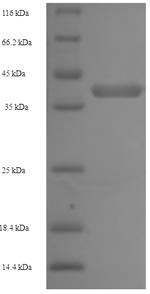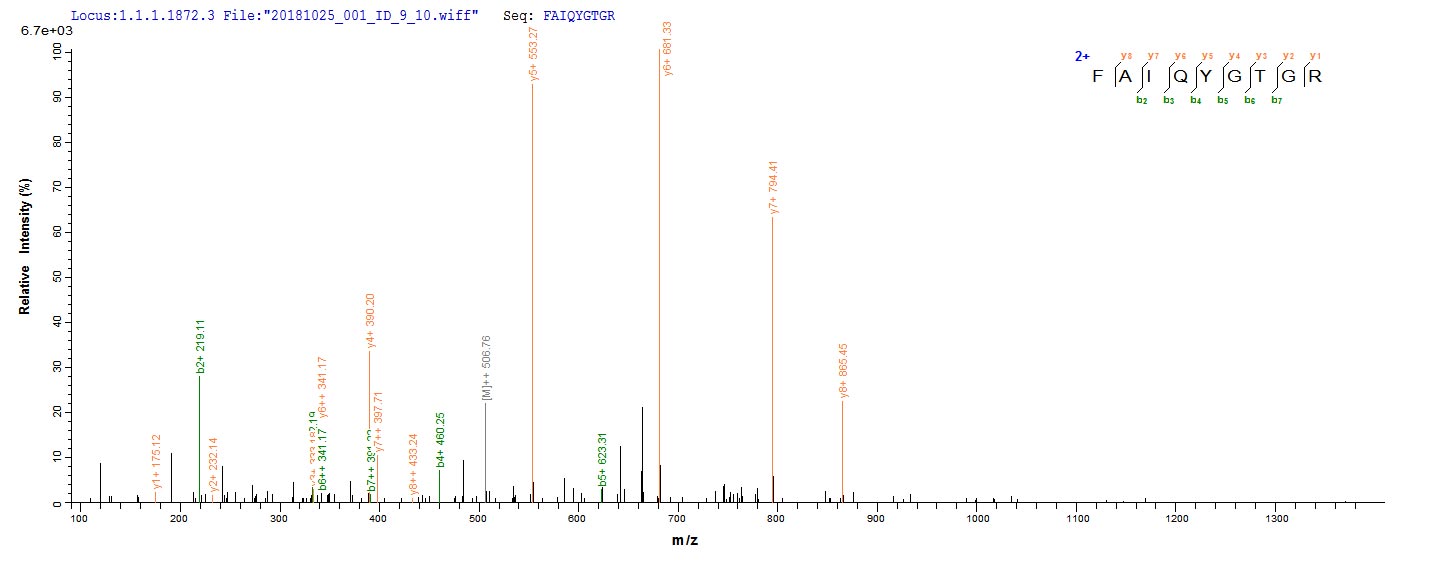Recombinant Human Napsin-A (NAPSA)
In Stock-
中文名稱:人NAPSA重組蛋白
-
貨號(hào):CSB-EP015452HU
-
規(guī)格:¥1344
-
圖片:
-
(Tris-Glycine gel) Discontinuous SDS-PAGE (reduced) with 5% enrichment gel and 15% separation gel.
-
Based on the SEQUEST from database of E.coli host and target protein, the LC-MS/MS Analysis result of CSB-EP015452HU could indicate that this peptide derived from E.coli-expressed Homo sapiens (Human) NAPSA .
-
Based on the SEQUEST from database of E.coli host and target protein, the LC-MS/MS Analysis result of CSB-EP015452HU could indicate that this peptide derived from E.coli-expressed Homo sapiens (Human) NAPSA .
-
-
其他:
產(chǎn)品詳情
-
純度:Greater than 90% as determined by SDS-PAGE.
-
基因名:NAPSA
-
Uniprot No.:
-
別名:Asp 4; ASP4; Aspartyl protease 4; KAP; Kdap; Kidney derived aspartic protease like protein; NAP1; NAPA; Napsa; NAPSA_HUMAN; Napsin 1; napsin A aspartic peptidase; Napsin A precursor; Napsin-1; Napsin-A; Pronapsin A; SNAPA; TA01/TA02
-
種屬:Homo sapiens (Human)
-
蛋白長(zhǎng)度:Full Length of Mature Protein
-
來(lái)源:E.coli
-
分子量:42.5kDa
-
表達(dá)區(qū)域:64-420aa
-
氨基酸序列KPIFVPLSNYRDVQYFGEIGLGTPPQNFTVAFDTGSSNLWVPSRRCHFFSVPCWLHHRFDPKASSSFQANGTKFAIQYGTGRVDGILSEDKLTIGGIKGASVIFGEALWEPSLVFAFAHFDGILGLGFPILSVEGVRPPMDVLVEQGLLDKPVFSFYLNRDPEEPDGGELVLGGSDPAHYIPPLTFVPVTVPAYWQIHMERVKVGPGLTLCAKGCAAILDTGTSLITGPTEEIRALHAAIGGIPLLAGEYIILCSEIPKLPAVSFLLGGVWFNLTAHDYVIQTTRNGVRLCLSGFQALDVPPPAGPFWILGDVFLGTYVAVFDRGDMKSSARVGLARARTRGADLGWGETAQAQFPG
Note: The complete sequence including tag sequence, target protein sequence and linker sequence could be provided upon request. -
蛋白標(biāo)簽:N-terminal 6xHis-tagged
-
產(chǎn)品提供形式:Liquid or Lyophilized powder
Note: We will preferentially ship the format that we have in stock, however, if you have any special requirement for the format, please remark your requirement when placing the order, we will prepare according to your demand. -
緩沖液:If the delivery form is liquid, the default storage buffer is Tris/PBS-based buffer, 5%-50% glycerol.
Note: If you have any special requirement for the glycerol content, please remark when you place the order.
If the delivery form is lyophilized powder, the buffer before lyophilization is Tris/PBS-based buffer, 6% Trehalose. -
儲(chǔ)存條件:Store at -20°C/-80°C upon receipt, aliquoting is necessary for mutiple use. Avoid repeated freeze-thaw cycles.
-
保質(zhì)期:The shelf life is related to many factors, storage state, buffer ingredients, storage temperature and the stability of the protein itself.
Generally, the shelf life of liquid form is 6 months at -20°C/-80°C. The shelf life of lyophilized form is 12 months at -20°C/-80°C. -
貨期:3-7 business days
-
注意事項(xiàng):Repeated freezing and thawing is not recommended. Store working aliquots at 4°C for up to one week.
-
Datasheet & COA:Please contact us to get it.
相關(guān)產(chǎn)品
靶點(diǎn)詳情
-
功能:May be involved in processing of pneumocyte surfactant precursors.
-
基因功能參考文獻(xiàn):
- These data indicated that napsin A expression may inhibit TGFbetalinduced EMT and was negatively associated with EMTmediated erlotinib resistance, suggesting that napsin A expression may improve the sensitivity of lung cancer cells to EGFRTKI through the inhibition of EMT. PMID: 29845258
- Although napsin A is infrequently expressed in endometrial carcinomas, positive results of napsin A immunostaining in endometrial neoplasms might support the diagnosis of clear cell carcinoma when the pathologic differential diagnosis includes other histologic subtypes PMID: 26945446
- it may be useful to combine NAPA and TTF-1 for increased sensitivity in lung cancer diagnostics. There is no substantial difference between monoclonal and polyclonal p40 and between different NAPA clones, whereas there is a difference between the TTF-1 clones 8G7G3/1 and SPT24 PMID: 26447895
- To the best of our knowledge, expression of monoclonal Napsin A in lymphomas has never been reported. ALK-DLBCL should be considered in the differential diagnosis when evaluating a Napsin A-positive tumor of poorly differentiated morphology and of unknown primary PMID: 26808134
- It is important for pathologists to be aware that breast carcinomas with apocrine features can express napsin A. PMID: 26842346
- High Napsin A expression is associated with adenocarcinoma in non-small cell lung carcinoma. PMID: 27412420
- Napsin-A, and Desmocollin-3 were sensitive and specific markers for the diagnosis of AC and SCC, respectively. Both markers allowed classification of 54/60 cases into either AC or SCC. PMID: 26710975
- napsin A is aberrantly expressed in a subset of lymphomas PMID: 26400099
- CK7, TTF-1 and napsin A are predominantly expressed in primary lung adenocarcinoma patients, with CDX-2 being inconsistently expressed. PMID: 26469326
- Combining HNF-1beta and napsin A may distinguish clear cell carcinoma from high-grade serous carcinoma, endometrioid adenocarcinoma and metastatic Krukenberg tumors. PMID: 26339401
- napsin A is another sensitive and specific marker for distinguishing ovarian clear cell tumors (especially adenocarcinomas) from other ovarian tumors PMID: 24721826
- Napsin A is expressed in a broad spectrum of renal neoplasms. PMID: 25889632
- Low expression levels of NAPSA is associated with lung adenocarcinoma. PMID: 25982999
- In diagnosis of ovarian clear cell carcinoma, Napsin A is specific but of intermediate sensitivity. PMID: 25551297
- Napsin A is frequently expressed in ovarian and endometrial clear cell carcinomas. PMID: 25971546
- Data indicate that polyclonal but not monoclonal napsin A antibody has a virtually universal nonspecific labeling in mucinous adenocarcinomas of various sites. PMID: 25521803
- These data suggest that napsin A may be a useful marker for identifying metastatic adenocarcinomas of pulmonary origin PMID: 24479710
- Our study showed that napsin A is an extremely sensitive (100%) marker of ovarian clear cell carcinomas PMID: 25389337
- Napsin A as a marker of clear cell ovarian carcinoma. PMID: 24191930
- PAX2 and napsin A have high specificity but low sensitivity and only have limited value in the differential diagnosis of mesotheliomas and renal cell carcinomas PMID: 23503645
- TTF-1 is more sensitive than napsin for detection of lung sarcomatoid carcinoma, and no cases were positive for napsin but negative for TTF-1 PMID: 24331839
- Napsin A is a sensitive and specific biomarker of the clear cell histotype in endometrial carcinomas and accordingly may have diagnostic utility in their histotyping. PMID: 24145649
- 24 cases each of pulmonary and esophageal adenocarcinoma were stained with TTF-1, napsin A, CDX2, 34betaE12, N-cadherin, and IMP3 in an attempt to find an optimal panel for differentiation. IMP3, CDX2, and N-cadherin are superior to either TTF-1 or napsin A. PMID: 23899066
- Napsin-A seems to be a useful marker in classifying primary pulmonary neoplasm as adenocarcinomas. PMID: 22914608
- A minority of anaplastic and poorly differentiated micropapillary pattern thyroid carcinomas are napsin A positive. PMID: 23681073
- Napsin B was duplicated from napsin A during the early stages of primate evolution, and the subsequent loss of napsin B function during primate evolution reflected ongoing human-specific napsin B pseudogenization PMID: 23333608
- Mucin-producing neoplasms of the lung infrequently express napsin A, suggesting that immunohistochemical assessment of napsin A may have limited diagnostic usefulness for distinguishing primary and metastatic mucinous adenocarcinomas involving the lung. PMID: 23355200
- investigation of expression of NAPSA (a potential diagnostic marker) in lungs/respiratory mucosa of subjects with pulmonary sclerosing hemangioma PMID: 23194051
- a useful immunohistochemical marker for differentiation of lung squamous cell carcinoma and adenocarcinoma from other subtypes PMID: 22495379
- absence of napsin A was an independent prognostic factor for reduced survival time in lung adenocarcinoma PMID: 22418245
- Nap-A was more specific than thyroid transcription factor 1 for primary lung adenocarcinoma versus all tumors, excluding kidney, independent of tumor type PMID: 22288963
- None of the 90 squamous cell carcinomas of the lung exhibited napsin A positivity in the neoplastic cells; however, strong napsin A reactivity was observed in hyperplastic type II pneumocytes and in intra-alveolar macrophages entrapped within the tumor. PMID: 22198009
- napsin A is a useful marker that can assist in the diagnosis of both lung adenocarcinomas and renal cell carcinomas[review] PMID: 22156835
- in combination with thyroid transcription factor-1-positive immunostaining helps in differentiating primary lung adenocarcinoma from metastatic carcinoma in the lung PMID: 21464700
- Although TTF-1 had a higher sensitivity, napsin-A was useful as a surrogate marker when encountering a poorly differentiated lung adenocarcinoma. PMID: 20830690
- Pronapsin A gene expression in normal and malignant human lung and mononuclear blood cells PMID: 12151090
- Napsin is a promising marker for the diagnosis of primary lung adenocarcinoma. PMID: 12698189
- role in the N- and C-terminal processing of pro-surfactant protein-B in type-II pneumocytes PMID: 13129928
- NAPSA suppresses tumor growth independent of its catalytic activity. PMID: 18195689
- A general defect in napsin A or cathepsin H expression or activity was not the specific cause for abnormal surfactant accumulation in juvenile pulmonary alveolar proteinosis PMID: 18216060
- The combined use of napsin A and thyroid transcription factor-1 results in improved sensitivity and specificity for identifying pulmonary adenocarcinoma in primary lung tumors and in a metastatic setting. PMID: 19740516
顯示更多
收起更多
-
亞細(xì)胞定位:Secreted.
-
蛋白家族:Peptidase A1 family
-
組織特異性:Expressed predominantly in adult lung (type II pneumocytes) and kidney and in fetal lung. Low levels in adult spleen and very low levels in peripheral blood leukocytes.
-
數(shù)據(jù)庫(kù)鏈接:
Most popular with customers
-
Recombinant Human Somatostatin receptor type 2 (SSTR2)-VLPs (Active)
Express system: Mammalian cell
Species: Homo sapiens (Human)
-
Recombinant Human Claudin-6 (CLDN6)-VLPs (Active)
Express system: Mammalian cell
Species: Homo sapiens (Human)
-
Recombinant Macaca fascicularis Membrane spanning 4-domains A1 (MS4A1)-VLPs (Active)
Express system: Mammalian cell
Species: Macaca fascicularis (Crab-eating macaque) (Cynomolgus monkey)
-
Recombinant Human C-type lectin domain family 4 member C (CLEC4C), partial (Active)
Express system: Mammalian cell
Species: Homo sapiens (Human)
-
Recombinant Human Cadherin-17 (CDH17), partial (Active)
Express system: Mammalian cell
Species: Homo sapiens (Human)
-
Recombinant Human Myosin regulatory light chain 12B(MYL12B) (Active)
Express system: E.coli
Species: Homo sapiens (Human)






-AC1.jpg)














